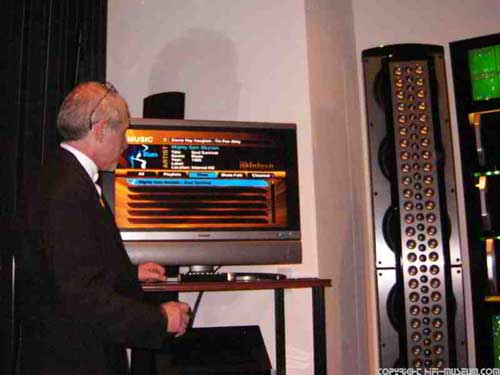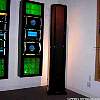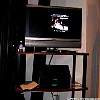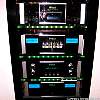West Coast Premier of
the McIntosh Reference System

We recently had the opportunity to attend the west coast premier of the McIntosh “dare to dream” reference system, which is McIntosh’s statement system. This system has been designed as a giant leap beyond the current state of the art state specifically to show what the Mac team is capable of – an analogy could be made to similar products in other fields like the Porsche Carrera GT or Ford GT.
The premier was held at the House of Music in San Francisco.
We had an opportunity to attend two presentations; we arrived in the middle of the first presentation and listened from the back of the room, and then we moved to the front row once the second presentation started.
The presentation started with an explanation of Mac’s goals for the system, and then a technical overview of how they went about accomplishing those goals. Once the talking had ended music was played, a great deal of music. Classical, Choral, Church, Vocal, Reggae, Blues and Popular music were all played. People in the audience were encouraged to submit their favorite disks and tracks to be played through the reference system. The McIntosh music server was also used.
The first question that everyone has is: how did it sound?
The first thing we were aware of was how coherent the sound was. Normally when listening to a large multi driver system we have been able to hear the individual drivers, especially up close. When listening to the Mac system up close we didn’t hear any difference in driver coherence than when we were standing in the back row. This implies very precise driver matching and a very well designed cross over network – this is just conjecture – we would like to hear Macs explanation as to how they did it.
The second thing that came across was the very high resolution and detail retrieval, especially at low volumes. One of the disks that were played was Sarah McLachlan Live, and the person who provided the disk mentioned that the sound was just like he had heard at the concert, only quieter. Many times we have heard large super systems, which were always cranked up too loud because they didn’t have good detail at quiet volumes. This was not the case with the Mac system; it didn’t need to be pushed to sound good.
The speakers appeared to be extremely efficient. The power output on the meters hovered around 0.2 to 2 watts, with about 10 watts rarely being hit on peaks. This was with very dynamic music with considerable heavy base energy.
The dynamic range and bass power of the system was immense with complete naturalness and freedom from fatigue and strain at very high acoustic levels. The sound retained its character regardless of sound levels. The presenter noted that one of the goals of the system was to equal the volume levels of live music. They seem to have more than accomplished their goal; the system appeared to have enormous amounts of dynamic reserves available.
There was a near complete absence of noise. Often times when listening to large systems after a crescendo you’re blanketed with noise – not with the big Mac system. We were sitting right in front, much closer than you would normally listen to a system of this size (unless you wanted it for near field listening!) and we didn’t hear any hiss or other noises, even though the tweeters were only a few feet away.
The sound character of the system was quite unique for a big system of this type. There was none of the blaring highs, holographic servo bass, etched in stone imaging or other artificial sound artifacts, which sound good for about two minutes but are fatiguing and unnatural and simply inaccurate.
The sound quality reminded us a little of the little Mc225 tube amp. This amp is well regarded, some (us included) consider it the cleanest classic Mac chrome because it has all the virtues of tubes but none of the slow rolled off character that many of the bigger classic tube amps exhibit.
Of course the reference system is orders of magnitude more advanced, but it shows that Mac still knows what music sounds like and the reference system has that small tube amp naturalness, only super sized. The speakers also sound like a simple design what with their incredible coherence, but have the dynamics of the large multi driver system that they are.
This system can really be considered a “dare to dream” system. Many Mac owners (us included) have long wished that Mac would design an all out, high end, cost is no object super system. Now the dream has become a reality.
For any one, a Mac enthusiast, or just a music lover who can afford, or at least appreciate the best, the Mac Reference System is an exciting development and well worth a look. McIntosh should give themselves a pat on the back for what they have accomplished.
 |

|

|

|

|

|

|

|

|

|

|

|

|

|

|

|

|

|

|

|
Since we already had a camera on hand we decided we might as well shoot pics of any other Mac gear that happened to be handy.

|

|

|
 |

|

|

|

|
House of Music’s storefront has a large graphic of the classic Mc1000 monoblock power amp, here is a pic.
 |